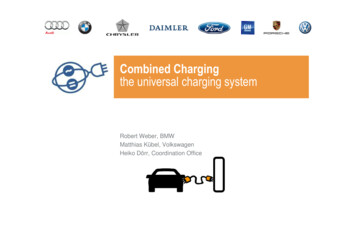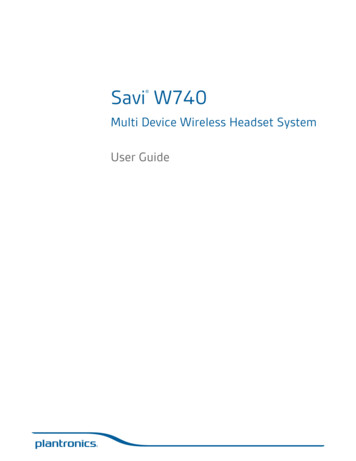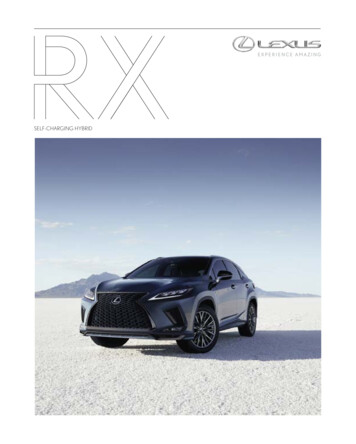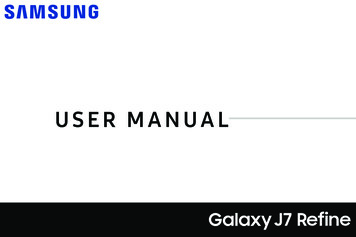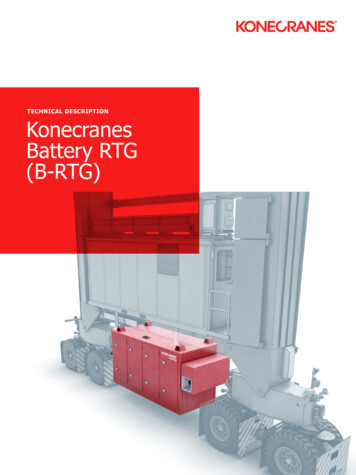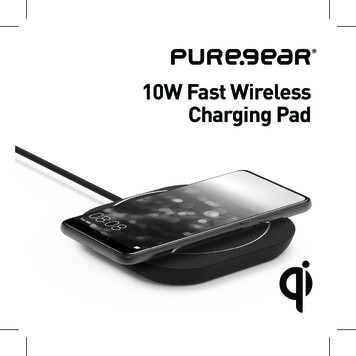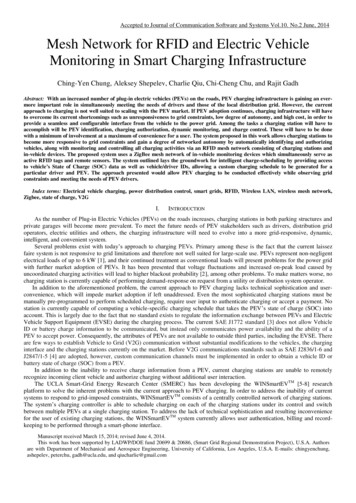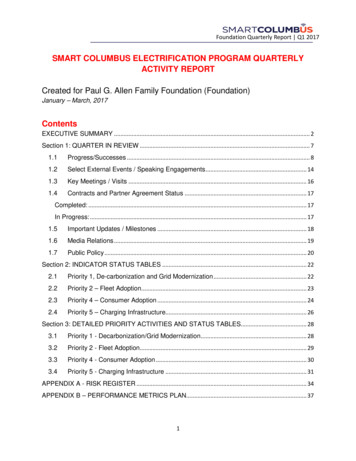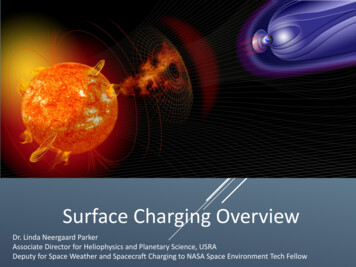
Transcription
Surface Charging OverviewDr. Linda Neergaard ParkerAssociate Director for Heliophysics and Planetary Science, USRADeputy for Space Weather and Spacecraft Charging to NASA Space Environment Tech Fellow
Outline Definition Why we care Physics Orbit limited theory Space charge limited theory Modeling as a circuit Orbit Characteristics and differences SummaryL. Neergaard Parker/SEESAW, Boulder 20179/4/20172
Satellite Charging Accumulation of charge (current) on or within the outer material of a spacecraft:surface and internal charging Factors of importance to surface charging Spacecraft orbit: GEO, LEO, polar, interplanetary, etc. Spacecraft geometry Material properties (insulating materials increase the threat) Environment parameters, including plasma, secondaries, sun intensity, ram/wake effectTypes of Discharges Flashover – discharge from one outer surface to an adjacent surface Punch through – discharge from outer surface to underlying ground Discharge to space – discharge from outer surface of spacecraft to ambient plasmaeV1keV101001Surface chargingL. Neergaard Parker/SEESAW, Boulder 2017MeV101001GeV10Internal charging1001 10100Radiation effects9/4/20173
Particle Penetration Depth100 MeV proton, 2” Al 50 MeV proton, 1/4” Al10’s eV e-10’s keV e- KaptonTPSAL substrateS/C body Geo – 10’s kV during substormsPolar - 1 kV during auroralprecipitation eventsLEO – few volts unless large voltagesolar arraysSolar wind – few volts positiveNote: positive currents generally resultfrom emission of low energy secondaryelectrons and photoelectrons, thepositive potentials that can be attainedare relatively modest.E 50 keV, 100 microns300 MeV proton, 10” Al1 GeV proton, 80” AlL. Neergaard Parker/SPA 626, fall 20164
Impact of Charging on the SpacecraftCauseElectrostatic potentials due to netcharge density on spacecraft surfacesor within insulating materials resultingfrom current collection to/from thespace environment.Electrodynamic (inductive) potentials –motion of the spacecraft through themagnetic field, plasma environment isnot requiredEffectImpactCurrents from electrostaticdischarges (ESD) Compromised function and/or catastrophic destruction ofsensitive electronics Solar array string damage (power loss), solar array failures Un-commanded change in system states (phantom commands) Loss of synchronization in timing circuits Spurious mode switching, power-on resets, erroneous sensorsignals Telemetry noise, loss of dataElectromagnetic interference EMI noise levels in receiver band exceeding receiver sensitivity Communications issues due to excess noise Phantom commands, signalsPower drains Parasitic currents and solar array power loss (LEOPhysical damage from ESD ESD damage to mission critical materials including thermalcontrol coatings, re-entry thermal protection systems, opticalmaterials (dielectric coatings, mirror surfaces) Re-attracted photo ionized outgassing materials deposited assurface contaminantsBiasing of instrument readings Compromised science instrument, sensor function Photoelectron contamination in electron spectrum Modified “Ion line” charging signature in ion spectrumCharacterize charging environment and build spacecraft to withstand or avoid charging eventsL. Neergaard Parker/SEESAW, Boulder 20179/4/20175
Anomalies and Failures Attributed to ChargingSpacecraftDSCS ger 11979JupiterAnomSCATHA1982GEOAnomGOES m/SFAUSSAT-A1, -A2, -A3FLTSATCOM 6071GOES 7Feng Yun 1ASurfaceESDOrbitCauseImpact*Intelsat K1994DMSP F131995LEOAnomTelstar 4011994,1997GEOTSS-1R1996LEOFailureTDRS F-11986-1988GEOAnomTDRS F-3,F-41998-1989GEOINSAT 1GEOAnomFeng Yun 1C1999LEOAnomBS-3A1990GEOAnomLandsat 71999-2003LEOAnomMARECS A1991GEOLOMADEOS-II2003LEOTC-1,22004 2GTO, GTOGalaxy 152010GEOEchostar 1292011GEO24 hr Pointing/positioning loss2011-2014LEOAnom2011PolarComputer upsetSurfaceESDAnom/LOMYear(s)1989-1994MOP-1, -2ESDLOMSpacecraftAnik E11991GEOAnik E21991GEOIntelsat 5111995GEOAnom1992-2001LEOAnomSuomi NPPMARECS A1991GEOLOMDMSP 15Anik E11991GEOAnik E21991GEOIntelsat ESD?SurfaceESDAnomSkyTerra-1Anom/LOMESD?L. Neergaard Parker/SPA 626, fall 2016AnomVenus Express,HughesNet-Spaceway 33-7-123-12ESDLOMAnomESDSEUAnomOffline for 3 weeksAnomoliesKoons et al., 2000Ferguson, 2015*Anom anomaly, LOM Loss of mission, SF system failure6
Space Weather Risk to SatellitesSpace Environment Impacts on Space SystemsAnomaly DiagnosisNumber --------------ESD-Internal, surface16254.1and uncategorizedSEU (GCR, SPE, SAA, etc.)8528.4Radiation dose165.4Meteoroids, orbital103.3debrisAtomic oxygen10.3Atmospheric s et al., 2000]L. Neergaard Parker/SPA 626, fall 20167
Surface Charging CodesSPIS(Roussel et al., 2005)Sun sideNascap-2K(Neergaard et al., 2001)MUSCAT(Hatta et al., 2005)Eclipse sideNascap-2k - USSpace Plasma Interaction System(SPIS) – ESASPacecRaft Charging Software(SPARCS) - Alcatel SpaceSpace Hazards Induced Near Earthby Large Dynamic Storms(SHIELDS) - LANLMulti-Use Spacecraft ChargingAnalysis Tool (MUSCAT) - JAXASPARCSL. Neergaard Parker/SEESAW, Boulder 2017(Clerc et al., 2004)Chart modified from Minow and KrauseSpacecraft Charging Tutorial, 20119/4/20178
electronsionsSurface Charging The net charge is due to the sum of the incident currents.photons𝑑𝑄 𝑑𝜎𝑑𝑉 𝐴 𝐶 𝐼𝑘 0 𝑎𝑡 ��𝑑𝑡𝑑𝑡𝑘 However, not just spacecraft current balance. Currentbalance is to each material Flux asymmetries due to magnetic field, electric field,ram/wake effect Sun/eclipse conditions Material properties High power solar arrays (LEO)Debye Length is the characteristic distance over which theplasma “shields” the electric field𝜆𝐷 𝑘𝑇4𝜋𝑞 2 𝑛𝑜 Ni Ne because ve vi Charging time scales seconds.Parker et al., 2016L. Neergaard Parker/SEESAW, Boulder 20179/4/20179
Charging Anomaly and Failure Mechanisms An electrostatic discharge (ESD) results when electricfields associated with potential differences (E - )exceed the dielectric breakdown strength of materialsallowing charge to flow in an arc Damage depends on energy available to arc𝐶 𝜀 𝐴𝑑1𝐸 𝐶𝑉 22Charging anomalies and failures depend on Magnitudes of the induced potentials and strength of theelectric fields Material configuration (and capacitance) Electrical properties of the materials Surface and volume resistivity, dielectric constant Secondary and backscattered electron yields,photoemission yields ISS MMOD shield 1.3 m chromic acid anodizedthermal control coating (T. Schneider/NASA)Chart from Minow presentationDielectric breakdown strengthL. Neergaard Parker/SEESAW, Boulder 20179/4/201710
Current Collection Plasma particles charge the spacecraft to approximately a few volts of theelectron energy At some potential, the spacecraft will attract an equal number of ions andelectrons. Currents: Incident ions (Ii) Incident electrons (Ie) Photoelectron (Iph,e) Backscattered electrons (Ibs,e) Conduction currents (Ic) Secondary electrons (Ise, Isi) due to Ie and Ii Active current sources (beams, thrusters, etc: Ib)𝑑𝑄 𝑑𝜎𝑑𝑉 𝐴 𝐶 𝐼𝑘 0𝑑𝑡𝑑𝑡𝑑𝑡 Orbit limited approximation (GEO, polar, interplanetary) Space Charge limited approximation (LEO)L. Neergaard Parker/SEESAW, Boulder 2017𝑘9/4/201711
Orbit Limited Approximation (Thick Sheath) Geosynchronous, polar, and interplanetary orbits where the Debye length is large comparedwith the spacecraft size Applies if any charged particle far from the spacecraft can reach the surface Low density, high energy – electron current exceeds the ion current so the spacecraftcharges negative Derivation is based on the conservation of momentum Repelled species is energy-limited𝐽𝑒 𝐽𝑒,𝑜 𝑒 𝑞𝜙/𝑘𝑇𝑒 Attracted species is angular momentum-limited𝐽𝑖 𝐽𝑖,𝑜 1 So then,𝜙 ��,𝑜𝐽𝑖,𝑜12 𝑘𝑇𝑒 𝑙𝑛𝑚𝑖𝑚𝑒 few times the plasma temperatureSince the electron current decreases exponentially and the ion current increases linearly –the principle effect of the spacecraft potential is to decrease the electron current.L. Neergaard Parker/SEESAW, Boulder 20179/4/201712
Space Charge Limiting Approximation (Thin Sheath) Dense, cold plasma (e.g. LEO) where the Debye length is equal to or smaller than thespacecraft Plasma density is such that the space charge of the attracted particles shields theattracting potential and thus limits the range of potentials As the spacecraft charges negative, the additional ions collected shield and thus limitthe range of the potential Repelled species is energy-limited𝐼𝑒 𝐼𝑒,𝑜 𝑒 𝜙/𝜃 Attracted species is space-charge limited𝐼𝑖 𝐼𝑒,𝑜 𝑓𝑎2So then, at equilibrium𝜙 𝜃 𝑙𝑛𝑓 2𝑎where f is a function describing the space charge from the spacecraft to infinityL. Neergaard Parker/SEESAW, Boulder 20179/4/201713
Circuit Model for Surface ChargingElectrical charging of the spacecraft can be modeled as a circuit where the plasma acts asa current source with a capacitance between the plasma and the spacecraft.Capacitance to ground𝐶𝑃𝑙 𝜀(differential charging)𝐴 𝐴𝑥10 6 𝐹𝑎𝑟𝑎𝑑𝑑𝐴𝐴𝐶𝑆𝐶 4𝜋𝜀𝑜 𝑅 𝑥10 11 𝐹𝑎𝑟𝑎𝑑24𝜋𝑅𝑅Capacitance to space(absolute charging)𝐼 𝐶𝑑𝑉𝑑𝑡Electroncurrent density(A/m2)Debye length(m)GEO (at 10kV)3.3e-6LEO (at 50V)Polar (at 1kV)Charging timeCharging timeto space (s)Charging timeto ground (s)100’s0.03 s3008.5e-32.4e-3 6e-8 6e-45e-67.40.00220 7e-4 7Solar wind7.3e-7(at50 V) Parker/SEESAW, Boulder 2017L. Neergaard10Capacitance tospace (F)1.0e-11Capacitance toground (F)0.1e-69/4/201714
Circuit analysis - 1 Material- - Material 1 L. Neergaard Parker/SEESAW, Boulder 20179/4/201715
Circuit analysis - 2 Materials- - Material 2 Material 1 L. Neergaard Parker/SEESAW, Boulder 20179/4/201716
Surface Charging Locations GEO charging is more prevalent in the midnight todawn sector. GTO, larger number in midnight-dawn sector, butsizable number at other local times Auroral charging occurs in the night timehemisphere of auroral regions.(Anderson, 2012)RBSP A, BParker and Minow, AGU 2014L. Neergaard Parker/SEESAW, Boulder 2017modified from Anderson, 20019/4/201717
Geosynchronous LANL 1989-046 23 March 1990During periods of significant hot plasmainjection, spacecraft may becomesignificantly charged relative tobackground plasma 10 kV in eclipse 1 kV post midnightL. Neergaard Parker/SEESAW, Boulder 20179/4/201718
Polar Rule of thumb Satellite is in darkness An intense, energetic electron ( 14 keV population)precipitation event is required(flux 108 electrons cm-2 s-1 sr-1) Locally depleted ( 104 cm-3) ambient plasma densityFontheim distribution Power law - models the backscattered and secondary electron fluxes, typically from 200InvertedeV – 1VkeV, Maxwellian, which models the energetic part of the spectrum, Gaussian, which models the inverted V part of the spectrum that represents the monoenergetichigh energy beam.Backscattered and secondary e- fluxes𝐹 𝐸 𝜋𝜁𝑝𝑜𝑤𝑒𝑟 𝐸 𝛼 𝐻 𝐸 𝐸𝑈 𝐻 𝐸 𝐸𝐿L. Neergaard Parker/SEESAW, Boulder 2017Energetic spectrumMonoenergetic high energy beam 𝐸𝐸 𝐸𝑜 𝜋𝜁𝑚𝑎𝑥 𝐸 𝑒𝑥𝑝 𝜋𝜁𝑔𝑎𝑢𝑠𝑠 𝐸 𝑒𝑥𝑝 𝑘𝑇Δ𝑔𝑎𝑢𝑠𝑠29/4/201719
Low Earth Orbit, Low Latitudes Surface charging generally a concern only with high power solar arraysEclipse exit Auroral eventInductive potentialത 𝑑 𝑆ҧ𝜑 ර൫𝐸ത 𝑣𝑥ҧ 𝐵)Eclipse entryL. Neergaard Parker/SEESAW, Boulder 20179/4/201720
Spacecraft Design Guidelines for Surface ChargingQuestions to ask: Will launch trajectory encounter regions of auroral charging threat? Will the encounter be in sunlight or darkness? Are sensitive electronics located near the insulation materials? Will RF noise interfere with critical up/down communications?Excerpts from NASA-HDBK-4002A Determine whether missions passes through/stays in charging regimes. Determine if threat is applicable to their spacecraft Modeling Testing (materials, components, circuit boards, etc)Implement mitigation techniques Shield electronics, cables Bond all structural elements Surfaces as conductive as possibleL. Neergaard Parker/SEESAW, Boulder 20179/4/201721
Summary Surface charging – 10’s eV – 100 keV Spacecraft charging is a complicated process based on thesum of the incident currents, material properties, highvoltage solar arrays, general orbit characteristics, etc. Orbit limited approximation Space charging limited approximation Build the spacecraft to withstand the charged particleenvironment.L. Neergaard Parker/SEESAW, Boulder 20179/4/201722
QUESTIONS?23L. Neergaard Parker/SEESAW, Boulder 20179/4/2017
SPacecRaft Charging Software (SPARCS) - Alcatel Space Space Hazards Induced Near Earth by Large Dynamic Storms (SHIELDS) - LANL Multi-Use Spacecraft Charging Analysis Tool (MUSCAT) - JAXA L. Neergaard Parker/SEESAW, Boulder 2017 9/4/2017 8 Sun side Eclipse side Nascap-2K (Neergaard et al., 2001) SPARCS (Clerc et al., 2004) SPIS (Roussel et al .
